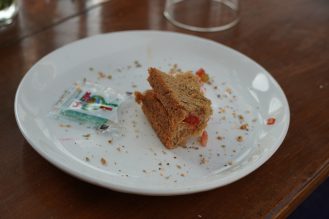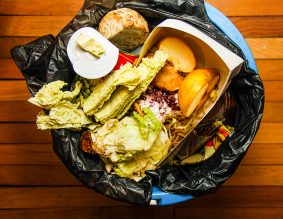Curbing Food Waste: Make Your Food Last Longer
Environment | October 12, 2022
We’re all guilty of throwing out perfectly good food. While we may have had the best intentions of eating it, it was left to spoil instead. Although this may seem harmless, it happens all too often.
Annually, Canadians discard more than $1,100 worth of food (roughly $17 billion worth of food waste yearly) according to the National Zero Waste Council’s research on household food waste in Canada.
Why does it matter?
Food waste directly affects the environment. Each year, approximately 2 million tonnes of food end up in our landfills. When food starts to decompose, it creates methane, a greenhouse gas (GHG) 28 times more potent than carbon dioxide (CO2).
Methane gas lasts in the atmosphere for up to 10 years and directly affects the ozone layer.
Wasted food also uses the resources that go into growing and getting the food to our tables. Every tonne of household food waste that is avoided is the equivalent of taking one car off the road each year. (National Zero Waste Council’s Love Food Hate Waste website)
So what exactly is food waste?
Food waste is food that has been discarded even though it was still good for consumption. Food waste can happen in many forms, including:
- Stocking up on too much food and not consuming it before it spoils (e.g. bread, vegetables)
- Disposing of food before it spoils (e.g. produce, meat)
- Throwing out leftovers or food scraps that could’ve been reused to make other dishes (e.g. fruits, vegetables)
- Throwing out half-finished items because they’re no longer being used or are needed (e.g. sauces, dips)
- Storing foods improperly so they don’t have a long shelf life (e.g. dairy, eggs)
- Disposing of food scraps in the garbage instead of placing them in the organic bin or compost (e.g. meat bones, coffee grounds, shells, tea)
So what types of foods are people throwing out?
A lot of good food ends up in our landfills. Most food waste comes from discarded meat, vegetables, fruit, bread and baked goods. Oftentimes, good food is wasted because we buy too much, don’t plan out our meals or fail to store our food correctly.
Looking to reduce food waste at home? Here are a few ways you can make an impact straight from your kitchen!
What’s in the fridge? Take note of what’s in your fridge – what do you use the most? What do you barely eat? Is there something that is close to its best-before date that you can use up?
Plan your meals – Meal prepping for the week has many benefits including using up food you’ve purchased, saving time and preventing you from overbuying items. Use up perishable items like dairy, seafood and meat first. Only buy what you need for the week.
Keep it fresh – Not all food is stored the same way, so learning how to store food properly can help prevent food waste. The fridge temperature should be set to 4°C or lower to keep produce fresh. Keep vegetables that tend to wilt like kale, lettuce or spinach, in a produce drawer with high humidity. You can also consider keeping fruits and vegetables, like cucumbers, peppers, apples and carrots in a low-humidity produce drawer.
Frozen but fresh – Made a tasty stew or soup but can’t finish it all? Try freezing it! Freezing food items can make them last longer. Things like bread, muffins, soups and vegetables can last up to six months in the freezer.
Get creative – A lot of the food that gets thrown out is perfectly edible or usable – like food scraps! Many times, it’s easier to throw it out then to have it take up space in the fridge. If there are things we’re consistently throwing out, there may be a creative way to upcycle them. For example, over-ripe tomatoes can be turned into a tomato sauce that can be used in many ways like pasta sauce with herbs, pizza sauce or marinara sauce. In addition, old herbs, leftover chicken or vegetables could be made into a delicious warm fall soup. For recipe ideas check out National Zero Waste Council’s recipe finder.
Beyond the Best Before dates – If your veggies are looking a little wilted, try soaking them in water to help rehydrate them. If you have some ripe bananas or blueberries, think about making pancakes for breakfast or other baked goodies like muffins or cake. Ripe fruit can also make for a delicious smoothie or power bowl. Got leftover veggies? Try roasting them, making a sauce or adding them to a soup.
Being more mindful about our food spending habits, what we buy, how we use it and when we use it is the first step in stopping household food waste. If you have food waste, make sure to put it in your backyard composter or your organics bin and never in your recycling or garbage. Learn more about organic waste: peelregion.ca/organics.
Curbing food waste in Mississauga
Last year, almost 26,000 people visited a food bank in Mississauga. Close to 1 in 28 people in our community can’t put food on their table. This is a serious concern that will only grow as the cost of food continues to rise.
In June, Mississauga City Council approved the City’s first-ever Urban Agriculture Strategy. The plan looks to grow more food locally to increase access to healthy foods for residents in their neighbourhoods. It will allow the City to diversify local food sources, increase the resiliency of our food supply, and address food insecurity in our community – all steps that will break down barriers to equitable access to healthy and nutritious food.
Learn more about what the City and the community are doing to support urban agriculture in Mississauga at mississauga.ca/homegrown.
Tags
Media contact
City of Mississauga Media Relations
media@mississauga.ca
905-615-3200, ext. 5232
TTY: 905-896-5151


